Update for the Ste. Julie E-fly This Past Summer
From: Louis Dionne email: dionnel@sympatico.ca
Hello Ken,
I was reading the December Ampeer and decided to give you some comments
about what I read.
First, about Keith's twin circuit. Nice. It seems to me that he is setting up the 2
flight packs in parallel with the 12 gauge wire serving as damper between the 2 circuit. The damper's intent being to get a better
match between the 2 motor output I would think.
Now if fuse blows on pack-B, the pack-A will then take the load of 2 motors until
the fuse-A blows as well. Therefore if a fuse blows, I don't think you can expect to be able to bring in the plane on one engine.
Unless you use twice the rating on your fuses.
Interesting anyway. I think I would prefer to have to independent circuits and risk
having a slight variation in trust between the 2 motors.
Second, Computer radio.
I have an older Futaba 8U with digital trims - with the first firmware revision. I
made myself a couple of Campacs and have therefore always 16 models stored. I wouldn't go back to the traditional radio. Of
course I made the mistake of trying to fly with the wrong plane at one point, but, we are all humans and whatever tools or
technique we use we are bound to make mistakes. My mental checklist before every flight includes checking the model name and
the traditional control surface inspection. But I just love the fact that all the trims and deflections are adjusted moving from one
model to the other as I typically switch flying planes often during my outings.
Third, the Ste Julie Fun-fly.
It was nice to see pictures of the C2VM August 26th event. Although I moved
from the Montreal area to the Ottawa area, it is nice to hang with my Montreal buddies. We had perfect weather. Strangely
enough, we only see planes and people from Ottawa beside Scott in this report.
Well, I guess Scott has not quite attained the highly difficult status of Frogman and
Quebecer; I will point out a few typos and mistakes. I believe it is Paul St.Arneauld, JC Terrettaz and C2VM stand for Club de
Vol a Voile de la Montťrťgie.
Vol a Voile would be translated to Soaring and Montťrťgie is a geological region
(like the Appalachian but with the tops spread much, much more) consisting of a number of hills spread apart and exposed by the
erosion of the St. Lawrence river plains. These hills are the remains of old lava shafts that never made to the surface and
solidified. Montreal is built on one of those nipples (Mount Royal). These hilltops are very old and the site a several hundred of
flora species only found at those hilltops. Anyway, I grew up on the hillside of the next one in sight (Mt.Bruno). On the other side,
we have Ste.Julie and where we held the E-Funfly.
Another correction, my Great Planes CAP uses an Astro 25 on Superbox and
either 18x 1700SCRC or 20x CP1700 and thanks to Picasso, now has a pilot at 6lb.10oz.
Enough ranting from my part, I hope everything is well on your side.
Return to "What's In This Issue?"
Albuquerque E-flight
From: Greg Mehojah gmehojah3@home.com

Hey Ken,
I am lucky to have started E-Flight in Albuquerque, NM, where we have a large
group of knowledgeable and fun e-flighters. Pat Trittle, Ken Williams, Dan Parsons, etc., all have great knowledge on e-flight,
and are more than willing to share it with everyone. It has definitely made my experience a fantastic one. One of the larger
interests here is in WWII warbirds. I have attached a few pictures showing some of the warbirds we have flying around here.
This is only a fraction of them!

On another note, I happened upon a picture of Keith Shaw's "Miss
Detroit" in S&E Modeler this month, and wondered if Keith ever publishes plans for some of these neat planes he
shows up with. Do you know if Keith ever has published plans, or is willing to publish for those of us drooling over his little
treasures?

Keep up the good work......it's cold, and time to get back to the building table.
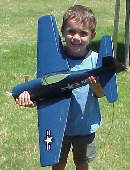
Greg
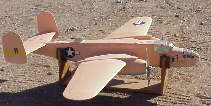
Nice planes Greg. Sorry, Keith doesnít build from plans, but I try to give as
much detail as possible when describing his planes in the Ampeer. To find out the techniques that he uses, his talk to the
EMFSO is archived on the EFO site. All his hints and tips are there. KM
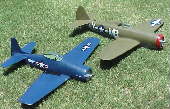 Return to "What's In This Issue?"
Return to "What's In This Issue?"
Great Planes Mfg. Ryan STA
From: Heather Rose email: HROSE@hobbico.com
Press Release for informational purposes only
Great Planes Mfg. Ryan STA Semi-scale, electric-powered Sport Model

More Info on Tower Site - Back Button to Return
It's Great Planes' newest electric classic.
When clean, quiet, electric power combines with the 'Golden Age' styling of the
popular Ryan STA, the result is a sharp-looking, smooth-flying R/C airplane that's sure to become a big seller! This is one
semi-scale project that builds as easily as it flies - with the potential for exciting scale aerobatics as well!
- Balsa sheeting makes it easy to re-create the original's rounded oval fuselage shape, and provides an ideal finishing
surface.
- Precision-formed ABS parts such as the cowl, wheel pants and head rest add defining details without work.
- A steerable tail wheel adds maneuverability to the stability provided by the wide-stance main gear - an ideal ground-handling
combination for first-time tail dragger pilots.
By removing one pin, the cockpit lifts out to reveal a spacious radio compartment, with plenty of room for all on-board gear.
Installation of the motor and gear drive takes only minutes, thanks to a large mounting area - and the ABS cowl completely encloses it all to preserve the Ryan's realistic looks. Scoops and vents in the cowl convert passing air into cooling power.
Dual aileron servos add razor-sharp response to aerial maneuvers; a semi-symmetrical, NACA 2412 wing lends support to smooth, stable handling. And by re-creating the full-size Ryan's checkerboard pattern on the wing's underside, pilots will have a high-visibility orientation guide.
"Satisfying as a sport flyer, a sound choice for a second or third plane, this electric-powered Ryan STA is a modern classic - a model that complements yesterday's graceful style with today's best building technology."
Don Anderson
President and Founder
Great Planes Model Manufacturing Company
Wingspan: 49 in (1245mm)
Wing Area: 401 sq in (25.9dm2)
Weight: 3-3.5 lb (1360-1590g)
Wing Loading: 17-20 oz/sq ft (51-61g/dm2)
Length: 36.3 in (920mm)
Requires: 4-channel radio w/4 mini servos, 600-size motor, C-30 or C-50 electronic speed control, gear drive, 7-cell 1700-3000mAh battery, charger, 2 rolls of Top Flite MonoKote covering
GPMA0165 Ryan STA EP
Retail $139.99 - Street 96.99
Return to "What's In This Issue?"
How Iíd Power the GP Ryan STA
By Ken Myers
To me, this should be a beginning performance plane. As a
beginning performance plane the numbers look like this:
Performance Type Plane: Ryan STA
Wing Area: 401 sq.in.
Target Wing Loading: 20 oz./sq.ft.
Target Flying Weight: 56.5 oz. or 3.5 lb.
Target Power System Weight: 28 oz.
Target Finished Airframe Weight: 19.75 oz.
Target Airborne Radio Weight: 8.5 oz.
Target Battery Weight: 18.8 oz.
Target Motor weight: 9.4 oz.
Prop Diameter: 9 in.
Prop Pitch: 7 in.
Target MPH: 61 mph
Target RPM: 8,755
Target Required Power Out: 162 watts
Motor Name: Astro Flight 035 geared 2.38:1
Expected Amps: 25.2 APC, 27.3 MA std wood prop
Number of cells: 9
The data for the power system weight indicates that the battery pack can be nine
Sanyo RC-2400 or the 3000 NiMH cells. The weight should be easily achievable and the performance should be very good.
Using only 9 cells, BEC operation could be okay, and an onboard Rx battery might not be required.
Return to "What's In This Issue?"
Thank You
A huge Thank YOU to Bill Ray of
Longwood, Florida. Bill was kind enough to send along a little extra with his Ampeer renewal. All of the EFO members thank
you very much, as your donation provided us with some refreshments for the December, January, February and March
meetings. Thanks, Bill.
Return to "What's In This Issue?"
Electric Model Design
Jim Zare
5123 Summer Drive,
Sylvania, OH. 43650
Email: jimzare@cs.com
In the past year many thousands of modelers have built and flown their first electric park or micro flyers. During the past two years I have designed and built and successfully flown several of these models.
EMD 1: Mini Rebel: 32" high wing cabin based on Hal DeBoltís 1956 gas model with 193 sq. inches of
area and a RTF weight of 7.5 to 11.5 oz. Powered by the MTM Hummingbird, the Potensky 2 or the Astro Brushless 010. With
a wing loading of only 5.6 to 8.5-oz./sq.ft. The Mini Rebel is easy to fly in a schoolyard or even a backyard and will loop, roll and
spin with the Astro 010. Plan set: $9.00 Laser cut balsa and plywood parts (ribs, formers, fuselage sides, rudder and stab
components): $15.00
EMD 2 Phantom Flash: a 38" replica of the ROG model with 195 sq. inches of wing area. RTF weight 6.5
ounces with the MTM Hummingbird. Flies 15 minutes on Nickel Metal Hydrides and one hour on Lithiumís. Plan set: $8.00
Laser cut balsa and plywood parts (ribs, formers, fuselage sides, rudder and stab components): $14.00
EMD 3 Dynamo 400: Electric powered sport sailplane with a 55-3/4 inches wingspan based on the Dyna Moe
and Jabberwock rubber models. For geared speed 400 motors. Plan set: $8.00 Laser cut balsa and plywood parts (ribs, formers,
fuselage sides, rudder and stab components): coming
EMD 4 Hummingbird: Electric powered low wing sport aerobatics with a 31-1/2Ē wingspan and 177 sq. inches
of area. Ready to fly weight of 11.5 ounces with Astro Brushless 010 or Speed 280 motors. Plan set: $8.00 Laser cut balsa and
plywood parts (ribs, formers, fuselage sides, rudder and stab components): coming
EMD 5 Firefly: a 46" ROG replica model with 295 sq. inches of wing area using the 6409 airfoil. RTF
weight 7.5 ounces. For MTM Hummingbird up to Speed 280 motors. Majestic glide, Flies 15 minutes on Nickel Metal Hydrides
and one hour on Lithiumís. Plan set: $9.00 Laser cut balsa and plywood parts (ribs, formers fuselage sides, rudder and stab
components): $15.00
EMD 6 Jr. Falcon: Electric powered version of the Carl Goldberg 1960ís 38" sport model, redesigned for speed
400 with simplified construction. Plan set: $9.00 Laser cut balsa and plywood parts (ribs, formers, fuselage sides, rudder and stab
components): $22.50 Canopy $3.50
EMD 7 Jr. Skylark: Electric powered version of the Carl Goldberg 38" sport model, redesigned for speed 400
with simplified construction. Plan set: $9.00 Laser cut balsa and plywood parts (ribs, formers, fuselage sides, rudder and stab
components): $23.50 Canopy $3.50
Shipping $3.95 per order US Priority Mail tube. Overseas add $10.00.
Check or money orders OK, no credit cards yet.
Conventional balsa and plywood construction is used in these models.
(The above is from an information sheet provided with Jimís models. Even though I have a Jr. Falcon kit, Iím
considering purchasing Jimís version. For those of you who donít know Jim, heís been in this phase of the hobby just
about forever. The partial kits are a great way to build, and nicely done. KM)
Return to "What's In This Issue?"
RBC Kits Update
From: Rob Bulk info@rbckits.com
Hello Friends,
May we wish you a very happy 2002 with good health and many building and
flying hours. We have updated our pages with the Micro Bearcat and added pictures of customers models, also we have
updated the links and dealer pages. The price list is changed into euro
The Panther and A10 worked on hard during the holidays. Under the
"News" page you will find the useful links and newest models.
Greetings and happy flying
Rob Bulk
RBCkits
Tel 0031(0)172-231869
Fax 0031(0)172-231866
Email: info@rbckits.com
Web: www.rbckits.com
Return to "What's In This Issue?"
New Motor In My Flash
From: Paulo "Chispas" Faustino rdd53650@mail.telepac.pt
Hi Ken,
Iím writing to you about the "new" motor I put on my Kyosho Flash. It
is a 12 turn Atom Smasher from Kyosho. Actually it was an 11 turn Terminal Velocity and a 12 turn armature (almost new) on
second-hand that was given to me by a guy from the R/C Car community. He got the new Corally Pro Series and is getting rid
of the Kyoshos, as they donít perform as expected.
I ended by putting the 12 turn armature in the 11 turn can and get these results:
8.4 volts - 3.45 gearbox - 9x7 MA prop - 9750 rpm - 32 Amps
8.4 volts - 3.45 gearbox - 9.5x7 Bolly prop - 8850 rpm - 36 Amps
9.6 volts - 3.45 gearbox - 9x7 MA prop - 10500 rpm - 38 Amps
On the Kyosho Hi-Torque the results are
9.6 volts - 2.92 gearbox - 9x7 MA prop - 9000 rpm - 23 Amps
I flew the Flash last Saturday and the performance is: Awsome!!! I almost had a
heart attack.
My local distributor is astonished and will get me a 14 turn K-Speed Helicopter
Special (like an 14 turn Endoplasma) with an all metal end-bell and an 17 turn similar to that one to try. The Endoplasma and
family are not available here right now. I intend to try an 10x8 CAM prop on the Flash, but the lack of height on the
undercarriage of the Flash is worrying me about the take-off. Some advice? (Maybe bigger wheels? KM)
(I received the following as a follow-up. KM)
Kyosho Atom Smasher-12 turn, "laid down" brushes:
8.4 volts - 3.45 gearbox - 9x7 MA prop - 9750 rpm - 32 Amps - 7x2000.
8.4 volts - 3.45 gearbox - 9.5x7 Bolly prop - 8850 rpm - 36 Amps - 7x2000.
9.6 volts - 3.45 gearbox - 9x7 MA prop - 10500 rpm - 38 Amperes - 8x2000.
On the Kyosho Hi-Torque, vertical brushes, all metal endbell, the results are:
9.6 volts - 2.92 gearbox - 9x7 MA prop - 9000 rpm - 23 Amps-8x2000.
On the 17 turn that I got today (they are wrong about the winding), similar to the
Hi-Torque, I will try an 2.38:1 gearbox, (I love that Kyosho gear that allows me to swap pinions and is cheap), with an 10x6
Kyosho and Graupner prop and Iím expecting 8200 rpm and 33 Amps on 7 cells and 8800 rpm and 38 Amps on 8 cells.
The Flash with 7x1250SCRL is close to 43.3 ounces or 1226gms. Great for flying
slow and low.
Paulo "Chispas" Faustino
Portugal
Return to "What's In This Issue?"
Upcoming Second Texoma RC Fly-in
From: Wendell Hubbard gwhtoo@texoma.net
The Texoma RC Club will be holding the Second Annual TRC Electric Fly-in
Saturday, April 27, 2002 at the club field just west of Sherman, Texas. We have paved and grass runways available with plenty of
room for all types of activities. We can have Zagi Combat, speed 400 pylon or any other events that participants would like to
arrange. Last years inaugural event was enjoyed by those participating and we would like to see more people get involved this
year. For more information contact me at hubbardwendell@hotmail.com or see the club web site at
www.texomarc.com (this site is still in the process of being updated to include this
event). The fly-in is an AMA sanctioned event and AMA membership is necessary to participate. There is a ten dollar entry fee
that includes the entrants lunch.
We look forward to having an even better event this year than we did last year. So
mark your calendar and plan on attending! More information will be provided as we get closer to the event.
Return to "What's In This Issue?"
New Parkflyer Kits Available
From: Allan Wright aew@mediaone.net

Ken,
I just wanted to let you and your Ampeer readers know that I have started shipping
laser cut kits of my Electric Mite parkflyer airplane. Some of your readers may have seen photos or read discussions about the
prototypes on the RC Microflight discussion boards. The plane flies on the GWS IPS direct drive system and is a great plane for
beginning builders or experienced flyers wishing to wet their feet in micro sized electrics.
Stats on the plane are:
Span: 28"
Chord: 5.5"
Length: 16.75"
Channels: 3
Weight: 5-6 oz.
More information can be found on my website at: www.wrightbrothersrc.com
Return to "What's In This Issue?"
Nieuport 17
From: Didier Aouizerats D.AOUIZERATS@laphal.com

Hello from French frozen boy,
Thanks for writing. Unusually cold weather in the south of France makes me stay
home. My Nieuport Ni17 building's completed. Nice to see. Iím thinking of covering. Control is: Rudder, elevator, ailerons and
ESC. Motor is S400 (new ones with ESC soldered back, a little bit more powerful as have been told) with 2.33 gear.
I will ill try 10x7 APC prop or 9x6 Cam prop (got the second one in stock)
The power pack Iíve decide to use is 8x2200 mAh Sanyo NiMH.
Without covering (I'll do this WE), take off weight is 772 grams (about 28 oz).
Happy to get under 800 grams. There are 2 5.6g servos for ailerons, 2 8g servos for rudder and elevator. Receiver is a light Jeti
5 channels.
Iím Still asking myself about lower wing. Looks so thin.
Got some worries with the wheels. Didn't find enough light ones, nor right size, so I
did them myself, with 0.4 mm plywood, 6 mm Depron and durit. (hope it's the right word).
The front cowl is from a "Tupperware" I've stolen from the kitchen...
Iím so proud of my Ni17 now. I hope it will fly on Christmas day. Will report with
some photos, for friend of mine got a scanner.
Didier
(Didier then followed up with a flight report. KM)
Back to job after some holidays. Weather was cold, cold, cold. We aren't used to
having snow here. It was surprising to see the beach all white and kids playing with snow while some people went to swim.
It's not easy to fly anything in this weather. My N17 was out only last WE, and it
FLIES. Slowly enough, as a WW1 fighter. I had to change the prop and now it's a 11x7 Cam prop. Didn't try any aerobatics. I
just flew to see reactions. Landing is .... whaou... or I'm not as good as I thought. I did 3 "Chevals de bois" (sorry do
not know the translating to say that the plane ends up on the upper wing, so let me know if you do). Thinking to use a folding prop
to prevent more damages next time.
Return to "What's In This Issue?"
Fenix 400
From: Sture Smidt sture.smidt@komtek.no

Photo of Fenix 400 from: www.komtek.no/fly/S_Models_mainpage.htm
Hi,
Long time, no hear. How is the Fenix 400 project going?
I wish I lived closer to you as I then could attend your electric meetings as well. I
am now into 30 cell helicopters and I have plans for a 30 cell F3A ship next year. A 15 cell brushless ship is underway (old EZ
Sportsman low winged, new in box).
I am still flying my ECO 8 on 10 cells and my Arrow EDF on 10 P2000 cells.
Feel free to visit my home page(s), see below.
Med vennlig hilsen
Sture Smidt
Sture Smidt
Formann
Moss Modellhelikopterklubb
Addresse: Bratengaten 90, NO-1515 Moss
Tel: +47 69266044, Mob: +47 90624117
Fax: +47 69268067, Priv: +47 69274003
Internet: www.komtek.no/fly/fly.htm
I am embarrassed to say that I did not have the time to build the Fenix
400. I did pass it on to an EFO member to build and report on, but Iíve heard nothing from him, as he too had a
horrible 2001. Iím sorry that our personal lives have delayed a report on this neat little S400 plane. Iíll try and retrieve
the kit and either do it myself, or find an EFO member looking for just this type of neat little project to do. KM
Return to "What's In This Issue?"
Follow-up on the XB-70 Flight
From: Grant Calkins CasinoOp@worldnet.att.net
Ken,
Thanks for the nice article in the December 2001 Ampeer on Ray Cannon's
and my flights at the Edwards AFB model flying field last July. Well, success was achieved on Nov. 21 for Ray's XB-70 with 4
Plettenberg/WeMoTec EDFs.....to the sky it went!
For reference to those who might wish to congratulate Ray, our email addresses
are as follows:
Ray Canon: bernice4@gte.net
Grant Calkins: CasinoOp@worldnet.att.net
Grant Calkins
Camarillo, CA
Return to "What's In This Issue?"
A Different Kind of Delta
From: Ray Williams rwilliams@babe.net.au
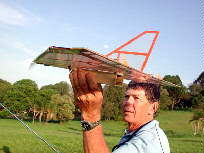
Hi Ken,
I recently found an article on a planform delta constructed from one eighth balsa.
To make it fly needed a 6 volt motor driven by a 9.6 volt cell pack. This sounded a bit extreme for the motor and, having just
built and now madly flying an Elipstik 460, I thought, why not do a Tom Hunt on this plan, dusted of the drawing board and
proceeded to design a 2 foot delta stik.
The result an airframe weighting 1.5 oz [ 44 gms] and an aircraft with a total
weight 12 oz [ 342 gms].
A few test glides over long grass, some minor adjustments of reflex and control
throws indicated "The Sledge" was ready for a test flight.
The flight proved it was fast and controllable, but, with the usual delta sink in turns.
Glide sink rate was manageable. The initial flight used 8x700 NiMH powering a 7.2 volt motor and while adequate lacked punch.
The power train [after consultation with Tom Hunt ] became 7 x 600AE and a 7.2
volt motor turning a Gunther 5x 4.5 push on propeller. Subsequent flights proved this to be the correct power train. The aircraft
gets around briskly for about 5 minutes on 80% throttle and there is still enough left for a powered landing.
Happy Landings
Ray Williams
Return to "What's In This Issue?"
10-Cell BEC
From: Robert Comerford flyelectric@dodo.com.au
Hi Ken,
Ken, my name is Bob Comerford. I live in Glen Innes in northern NSW in Australia
where it is a balmy 28 degrees (thatís Celsius folks!) as I write on Christmas Eve.
I have been playing with electric flight since the seventies. I was reading your
December Ampeer and was a little confused in the article on the PT Electric saga. You write that a BEC controller
cannot be used with 10 cells, and as I use that combination on my sport planes, I was wondering if you do not see such things as
Shultze ESC's your way. (Yes, we have Shultze ESCís available here. KM)
I also wonder about the suitability of the Olympus belt-drive unit. Yes, it is ideal for
motors that do not have adjustable timing and maybe it is cheap over your way, however the quality of construction leaves a little
to be desired in the hands of a someone with limited experience don't you think? (Yes, quite possibly. KM) Maybe you
have posted modifications or user reports for this item on your newsletter before. If you have I would appreciate having a look at
them sometime. (No I havenít, but thanks to you, there are now some hints now! :-) KM)
While I agree that there are 10-cell BEC equipped ESCs available, and Iím
using one on a 10 cell battery in my SR Batteries Cutie right now, I donít generally recommend them in planes that draw
20+ amps and have more than two flying functions. To ME, the weight penalty of a couple of ounces for a
270/300 mAh receiver battery on the type of plane that uses 20+ amps, just doesnít seem worth the potential RF
interference and possible over-current draw of some servos. Thanks for your input. KM
Here are Bobís Mods to the Olympus Belt-drive:
Mod 1: to stop the output gear moving when tightening up the prop nut, I
pin the output gear to the shaft by drilling a hole just big enough to insert a small nail about half way along the thin section of the
output gear. I have just pushed the nail through, bent it over and cut it off. Some of mine are probably on the centre line some are
probably not that accurate. They all work and while I probably was worried about accuracy and balance when I first did this
many years back I found it unnecessary in this application.
The second modification I have just tried was in an effort to solve two problems.
I had an Australian rare earth motor that has straight cut armature slots and
magnets. The cogging effect leads to some noise in operation with any of this style of motor construction. When added to a
regular spur gearbox (in this case a Leisure 3:1 short gearbox) this noise is amplified to a level I simply do not find acceptable. I
thought by using a belt drive I might reduce the noise to an acceptable level. The other problem I have found with these
gearboxes is the ease at which the belt will find a way to depart company with the gears (this is why I have some of these lying
around in my parts box for many years). This is bad enough with around 100 watts input but in this application I am using around
350 plus watts input to the motor. I found that by reversing the motor gear I could just get the screw to tighten on the motor shaft
and get most of the belt (but not all ) running on the output gear.
If I had thought of reversing the motor gear before I had pinned the output gear
then it may well be possible to line the belt up perfectly.
I pulled the belt up TIGHT and tried it. Voila! Sounded really nice in the air and no
problems with belt coming off.
As it has had only about 20 flights so far I consider this not much of a test of
longevity, however as I have never had that many flights before without troubles (at even a 100 watts input) I feel this is a useful
modification. By the way -the controller does have a brake which does get activated sometimes in flight to add further stress to
this setup. The belt looks fine with no signs of visible wear from not being in perfect alignment. If some of your readers have
some of these gearboxes floating about, and like me, are not one to throw something away (without one more go at it) then this
may be worth them trying. I have one more example of this brand of motor that I now want to run geared and for that I will be
trying one of the current breed of American belt drives as you suggested. Unfortunately I don't have facilities to post a picture
which would make the mods so much clearer.
Return to "What's In This Issue?"
Radical Edge 540
From: Dave Thacker DAVTHACKER@aol.com
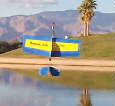
The new Radical Edge 540 is done and ready to ship! You'll be amazed! Torque
rolls, hover, rolls, snaps, inverted, knife, you name it! All this on simple inexpensive gear!
E Cubed ANTENNA! We've got a good supply of the new super short
(5.5"!!!) wound and tuned antennas. Great to drop weight and get rid of hanging wire on your GWS and other micro RX
ships. $10 each.
Radical RC Black Diamond 301 motors are here! Due to limited supply only
available with purchase of a new Edge 540 kit. Mo-power Mo-power Mo-power!
Happy Flying!
Dave Thacker, www.radicalrc.com
Voice 937-237-7889
Fax 937-237-1521
RADICAL RC - The best in R/C electronics. Servos, Receivers, Wiring, Harnesses, Switches, Wire, Sanyo Packs NiCad
and NiMH.
Return to "What's In This Issue?"
1/2A Lanzo Bomber
From: Stuart Pearce spirit-kits@soy.on.ca
Spirit of Yesteryear introduced its latest kit. It is a 1/2A - Speed 400 Lanzo Bomber. It
is called the "Bantam Bomber". Price TBA but it should be approximately $55-60. It will feature laser cut parts all
hardware including light, hard foam wheels.
Return to "What's In This Issue?"
The SR Batteries Bantams
Reprinted with permission from the FYI E-Newsletter from SR Batteries, Inc.
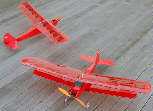
Larry ran a contest to name his latest two planes. Hereís what his
newsletter said:
The response to this contest has been super. We've gotten email messages from all over the world. There were a lot of great names suggested and some that made
us wonder about some of you.
There were over 1000 suggested names. We had a team of four people reviewing the suggestions and we slowly narrowed down our focus to about 12 names. Then, we got it down to 4. Finally, we got it down to one finalist and the names we chose were the SR Bantam and SR Bantam Bipe. They were submitted by Sal C. and
Sal wants an SR Bantam Bipe for his very own. As soon as we release the kits, he'll get the first one.
We thought Bantam had a nice ring to it and when we looked Bantam up in the dictionary, we found... small, spirited fighter, light in weight, small in size, laughably aggressive. Sounds like the SR Bantam and SR Bantam Bipe to us!
For those of you who missed the beginning of the contest...
The concept behind the SR Bantam and SR Bantam Bipe is that they use the power system and radio system that's used in the typical GWS Pico Stick, Cub, or Tiger
Moth. If you've busted up one of the GWS airplanes, you can move everything over to one of our two new kits.
The SR Bantam is a monoplane. It has a 39" wing span and 210 square inches of wing area. All up weight, ready to fly, is 8 ounces. Naturally, we'll supply more technical specifications a little later on.
The SR Bantam Bipe is a biplane. It also has a 39" wing span and its wing area is 380 square inches. All up weight, ready to fly, is 8.8 ounces!
Both ships can be flown very slowly, but the biplane is by far the slower of the two because of its lower wing loading.
We've been flying both ships extensively in an indoor basketball court (90' x 75' x 20' high) at the Seneca Middle School, in Holbrook, NY.
Both have more than enough power, so flying outdoors is no problem as long as you remember we're talking about 8 ounce airplanes. They handle the wind much better than the GWS kits because they are much cleaner aerodynamically, but fairly calm winds are a good idea for your first flights.
Here's a link that will take you to a sneak preview of the SR Bantam and SR Bantam Bipe...
www.srbatteries.com/fyi/newkits/gallery.htm
Thanks to everyone,
Larry email: larry@srbatteries.com
Return to "What's In This Issue?"
Mega Motor USA
From: Ken Mizell email: mizell@seanet.com
Ken:
We are bringing Mega Brushless and Brushed motors to America.
www.megamotorusa.com
Take a look. We have great motors.
Ken Mizell email: ken@megamotorusa.com
Return to "What's In This Issue?"
Scale Pilot for E-power
From: Walter Thyng email: docwt@lightfirst.com
I thought I'd share a discovery (at least it is for me) with you. In the recent MAN
(Jan. I think) there was an article on pilot figures. I spotted Acadian R/C (www.acadianrc.com).
They have 1/6 and 1/8 scale partial and full-bodied pilot figures. The full-bodied figures weigh approximately ONE OUNCE!
I ordered one for the P47N (modified Top Flight Gold Edition) I am working on. It
fits the cockpit kit quite well. The details are fantastic. Like any unfinished pilot figure it will take some work, but it's going to be
worth it.
Oh, Yes, the priced for a full-bodied figure is $8.95. I paid 3.95 for shipping and
had it in three days. These are absolutely great for electric flyers who want some realism. Check'em out.
Return to "What's In This Issue?"
John Sermos has passed on
From: Ron Torrito R_Torrito@aol.com
Dear Ken:
My wife Renee and I have received a card from Jean Sermos saying that her husband John
Sermos has passed on. We had the pleasure of knowing John for many years and had used his "Sermos R/C Snap Connectors"
both for our hobby needs and for my work in designing high amperage DC power fixtures for Power Systems. Cards can be sent to:
Mrs. Jean Sermos
28 Jay Road
Stamford, CT 06905-1021
Return to "What's In This Issue?"
To Reach Ken Myers, you can land mail to the address at the top of the page. My E-mail
address is:
KMyersEFO@aol.com
EFO WEBsite: http://members.aol.com/KMyersEFO/
|














